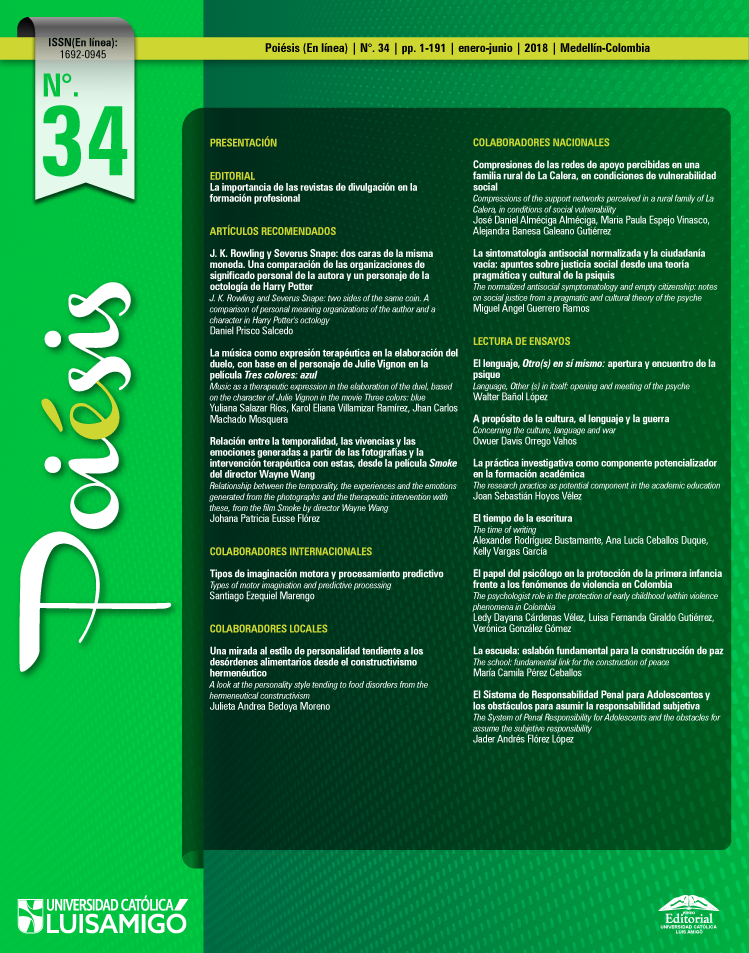Tipos de imaginación motora y procesamiento predictivo
DOI:
https://doi.org/10.21501/16920945.2787Palabras clave:
Entrenamiento, Imaginación motora, Procesamiento predictivo, Técnicas deportivas.Resumen
El entrenamiento con imaginación motora es una herramienta muy utilizada para mejorar la ejecución de técnicas deportivas. La teoría del procesamiento predictivo aplicada a la cognición ofrece una buena alternativa de explicación para este fenómeno, mostrando cómo fluye la información en el sistema motor mientras se ejecuta una acción y mientras se la imagina. Sin embargo, una errada taxonomía de los tipos de imaginación motora podría sentar las bases para construir un modelo de procesamiento predictivo que no explique ciertas peculiaridades que se dan en el entrenamiento de técnicas deportivas. En este sentido, propongo una corrección de la taxonomía estandarizada de modo que permita al modelo abarcar esas peculiaridades.
Descargas
Referencias
Clark, A. (2015). Surfing uncertainty: Prediction, action, and the embodied mind. Oxford University Press. Capítulo 4: Predition-Action Machines.
Coelho, R. W., De Campos, W., Silva, S. G. D., Okazaki, F. H. A., & Keller, B. (2007). Imagery intervention in open and closed tennis motor skill performance. Perceptual and Motor Skills, 105(2), 458-468.
Colombo, M., & Seriès, P. (2012). Bayes in the brain—on Bayesian modelling in neuroscience. The British journal for the philosophy of science, 63(3), 697-723.
Decety, J., & Jeannerod, M. (1995). Mentally simulated movements in virtual reality: does Fitt's law hold in motor imagery? Behavioural brain research,72(1), 127-134.
Decety, J., & Michel, F. (1989). Comparative analysis of actual and mental movement times in two graphic tasks. Brain and cognition, 11(1), 87-97.
Decety, J., Philippon, B., & Ingvar, D. H. (1988). rCBF landscapes during motor performance and motor ideation of a graphic gesture. European Archives of Psychiatry and Clinical Neuroscience, 238(1), 33-38.
Epstein, M. L. (1980). The relationship of mental imagery and mental rehearsal to performance of a motor task. Journal of Sport Psychology, 2(3), 211-220.
Féry, Y. A. (2003). Differentiating visual and kinesthetic imagery in mental practice. Canadian Journal of Experimental Psychology/Revue canadienne de psychologie expérimentale, 57(1),
Grush, R. (2004). The emulation theory of representation: Motor control, imagery, and perception. Behavioral and brain sciences, 27(03), 377-396.
Hardy, L. (1997). The Coleman Roberts Griffith address: Three myths about applied consultancy work. Journal of Applied Sport Psychology, 9(2), 277-294.YVES-ANDRÉ FÉRY
Hardy, L., & Callow, N. (1999). Efficacy of external and internal visual imagery perspectives for the enhancement of performance on tasks in which form is important. Journal of Sport and Exercise Psychology, 21(2), 95-112.
Jeannerod, M. (2006). Motor cognition: What actions tell the self (No. 42). Oxford University Press. Pag. 12-16.
Jeannerod, M. (1994). The representing brain: Neural correlates of motor intention and imagery. Behavioral and Brain sciences, 17(02), 187-202.
Jones, M., & Love, B. C. (2011). Bayesian fundamentalism or enlightenment? On the explanatory status and theoretical contributions of Bayesian models of cognition. Behavioral and Brain Sciences, 34(04), 169-188.
Ridderinkhof, K. R. & Brass, M. (2015). How Kinesthetic Motor Imagery works: a predictive-processing theory of visualization in sports and motor expertise.Journal of Physiology-Paris, 109(1), 53-63.
Kizildag, E., & Tiryaki, M. Ş. (2012). Imagery use of athletes in individual and team sports that require open and closed skill. Perceptual and motor skills,114(3), 748-756.
Mahoney. M. J.. & Avener. M. (1977). Psychology of the elite athlete: An exploratory study. Cognitive Therapy and Research. 1. 135-141.
Mellet, E., Petit, L., Mazoyer, B., Denis, M., & Tzourio, N. (1998). Reopening the mental imagery debate: lessons from functional anatomy. Neuroimage, 8(2), 129-139.
Mizuguchi, N., Nakata, H., Uchida, Y., & Kanosue, K. (2012). Motor imagery and sport performance. The Journal of Physical Fitness and Sports Medicine,1(1), 103-111. Pag. 107.
Sirigu, A., Duhamel, J. R., Cohen, L., & Pillon, B. (1996). The mental representation of hand movements after parietal cortex damage. Science, 273(5281), 1564.
Stillman, B. C. (2002). Making sense of proprioception: the meaning of proprioception, kinaesthesia and related terms. Physiotherapy, 88(11), 667-676.
Stinear, C. M., Byblow, W. D., Steyvers, M., Levin, O., & Swinnen, S. P. (2006). Kinesthetic, but not visual, motor imagery modulates corticomotor excitability. Experimental Brain Research, 168(1-2), 157-164.
Yu, Q. H., Fu, A. S., Kho, A., Li, J., Sun, X. H., & Chan, C. C. (2015). Imagery perspective among young athletes: Differentiation between external and internal visual imagery. Journal of Sport and Health Science.
Descargas
Publicado
Cómo citar
Número
Sección
Licencia
La revista y los textos individuales que en esta se divulgan están protegidos por las leyes de copyright y por los términos y condiciones de la Licencia Creative Commons Atribución-No Comercial- 4.0 Internacional. Permisos que vayan más allá de lo cubierto por esta licencia pueden encontrarse en http://www.funlam.edu.co/modules/fondoeditorial/ Derechos de autor.










